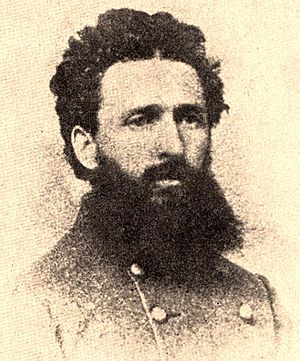Nicholas Bartlett Pearce facts for kids
Quick facts for kids
Nicholas Bartlett Pearce
|
|
|---|---|
 |
|
| Born | July 20, 1828 Caldwell County, Kentucky |
| Died | March 8, 1894 (aged 65) Dallas, Texas |
| Place of burial | |
| Allegiance | |
| Service/ |
|
| Years of service | 1850–1858 (USA) 1861–1865 (CSA) |
| Rank | Brigadier General (Arkansas State Troops) |
| Commands held | |
| Battles/wars | American Civil War |
| Other work | Merchant, college professor, land examiner |
Nicholas Bartlett Pearce (born July 20, 1828 – died March 8, 1894) was an important military leader during the American Civil War. He was a brigadier general for the state of Arkansas. Pearce led soldiers in one of the first big battles of the war. Later, he worked as a supply officer for the Confederate States Army.
Contents
Early Life and Military Training
Nicholas Pearce was born in Caldwell County, Kentucky. He went to Cumberland College before joining the United States Military Academy (West Point). He graduated from West Point in 1850.
After West Point, he became a second lieutenant in the United States Army. He was stationed in Arkansas and the Indian Territory. In 1858, he left the army to work with his father-in-law in Osage Mills, Arkansas. Pearce also briefly served as a Colonel in the Benton County Militia.
Civil War Service
Even though Pearce did not agree with states leaving the United States, Arkansas chose him as a brigadier general in May 1861. He was put in charge of the state's 1st (Western) Division of the militia. In June, he took command of Fort Smith.
Pearce's Troops and the Battle of Wilson's Creek
General Pearce set up his headquarters at Camp Walker near Maysville. His troops were called the 1st (Western) Division. They included several regiments of infantry and cavalry, along with artillery units.
When a Union army moved near Springfield, Pearce's troops were close by. Pearce joined forces with another general, Benjamin McCulloch. Together, they had about 10,000 soldiers. On August 10, 1861, the Union commander, General Nathaniel Lyon, attacked them.
This battle was called the Battle of Wilson's Creek. The Union commander was killed, and his troops had to retreat. Pearce's Arkansas soldiers helped win the battle. However, they also lost many men. Two Arkansas units, the 1st Arkansas Mounted Rifles and the 3rd Arkansas Infantry, had many soldiers killed or wounded.
End of State Service
After the battle, Arkansas wanted to transfer Pearce's troops to the Confederate army. General Pearce did not want his troops to join the Confederate army. Sources disagree on how many soldiers agreed to transfer. By the end of September 1861, most state troops had either joined the Confederate army or left military service.
From December 1861 until the end of the war, Pearce worked as a major in the Confederate Commissary Department. This department was in charge of supplying food and other goods to the soldiers. He worked in Arkansas, the Indian Territory, and Texas. In June 1865, he was released from service in Houston, Texas. He then received a pardon from President Andrew Johnson.
Life After the War
After the war, Pearce went back to Osage Mills, Arkansas. He rebuilt his home, mill, and store. In 1872, he became a math teacher at the University of Arkansas. He left this job in 1874 and returned to Osage Mills.
Later, he worked for a wholesale company in Kansas City. He then moved to Texas for his wife's health. There, he worked as a land examiner.
Nicholas Bartlett Pearce passed away in Dallas, Texas, on March 8, 1894. He is buried in Whitesboro, Texas.
Images for kids


